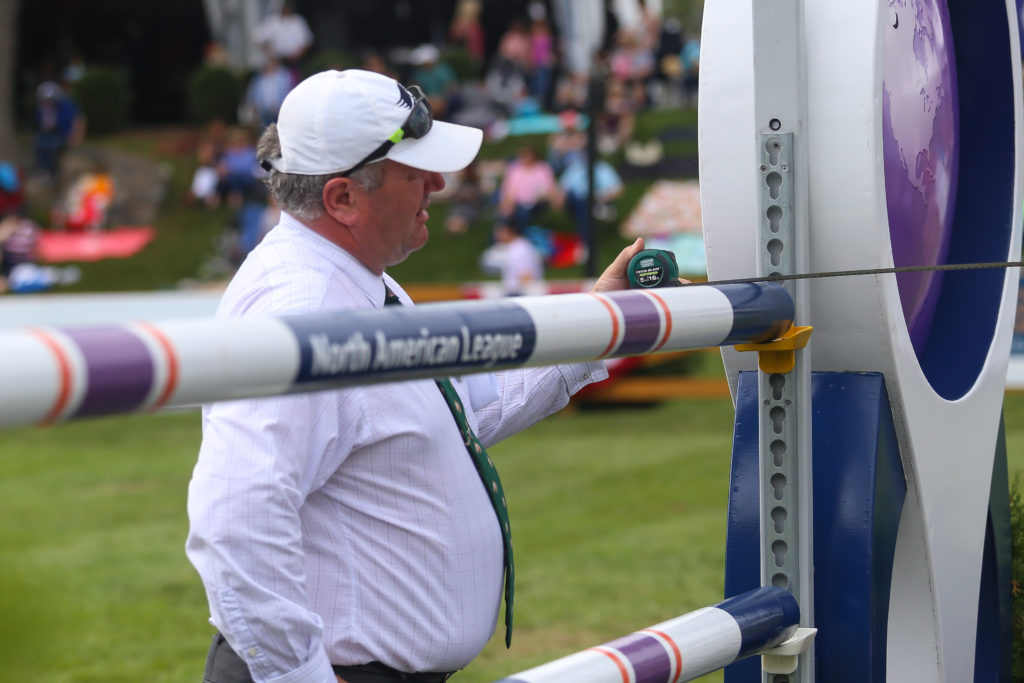By Armand Leone, Jr.

When it comes to course designing in the jumper rings, safety of the horse and rider are the greatest concern. However, it’s also a course designer’s job to create a track that presents a level of difficulty that is appropriate for the class. If you only get one clear in the grand prix, the course is too hard. On the other hand, if you get 15 clears, it’s too easy. Striking the elusive balance between competitive yet safe is what makes this profession unique. What do course designers need to keep in mind when designing for various levels? When the course causes problems that could be perceived as dangerous, who is liable? The answers aren’t necessarily straight forward.
There is a difference between building tracks for children, juniors, and adults, versus building tracks for upper-level riders and professionals. When designing for the former, it’s probable that the riders are less experienced, and, therefore, you need to keep the primary focus on the safety of the rider. When designing for the latter, you’re probably dealing with more seasoned riders, and need to keep the focus on the safety of the horses. The inexperienced rider and the inexperienced horse make different mistakes.
Designing a Track for Less Experienced Riders
In children, adult, and lower-level divisions, course designers have the duty to prevent the rider from getting themselves into trouble. Generally speaking, it’s not the jump height that will cause issues, but rather the questions being asked of the rider. For example, if the end of a course has a long run to a vertical-oxer two stride combination, you risk the rider not recognizing that the horse could jump it in one stride instead of two. If this isn’t anticipated, the rider gets left in the “back seat” going backwards and upwards while the horse leaps out from underneath resulting in an ugly crash. On the other hand, the same vertical two-stride oxer in-and-out off of a rollback does not create a rider hazard. This is just one example of a problem not suitable for less experienced riders. In these lower-level classes, a course designer’s goal is to reduce the risk of a rider-imposed injury without diluting the rider’s jumping experience. Course designers need to keep in mind the potential lack of experience of the riders in these lower-level classes.
Designing a Track for Developing Horses
Professional divisions as well as high junior and amateur divisions and up generally have increased difficulty as the track height and purse increase. Course designers are building for a more educated rider but with horses of differing experience. In these instances, the safety of the horse becomes the primary goal. Experienced riders who have walked the course know what to anticipate. However, when the horse gets fooled on course—which can often be the case with a greener horse—it can be problematic. Not all horse errors are correctable by a rider and, if a horse gets fooled, a rider can get hurt. This typically involves distance-related questions that cause an inexperienced horse to misjudge the fence. The difficulty of the “distance” question increases with higher levels of competition, but at the end of the day, the question must be fair. By including short- and long-distance questions, and through careful selection of obstacle construction, a course designer can increase the course difficulty with little or no change in the actual size of the jumps. At a multi-day show, courses need to follow a progressive pattern of increasing difficulty during a show from the initial class in the division to the final event.
What Happens if the Course Is Bad?
Even with the best intentions, issues can arise that put the safety of the course in question. However, it is not only the course designer that is responsible for the course. Horse show stewards and knowledgeable exhibitors should bring a safety concern to the attention of the course designer if there is a perceived problem. At higher level Fédération Equestre Internationale (FEI) events, there are ground juries overseeing the competition. While exhibitors may get upset over a course design, if the design falls within the specifications for the class, the main thing a course designer risks is not being asked back in the future.
On the flip side, if the course was not set within the class specifications and an injury to a competitor occurs, one would expect a rider to investigate the potential for legal recourse against the course designer, show management, and/or the official responsible for stewarding the class.
The Bottom Line
The bottom line is the course designer has the duty to keep the safety of the rider and the horse in mind. When designing courses for non-professional riders, the less-experienced rider should be top of mind. In the professional divisions, the safety of the horse should be the overriding concern, and courses need to educate and develop horses as well as test them. At the end of the day, even with a beautifully designed and safe course, issues can arise and that is the risk and challenge we all face as horse people.
This article originally ran in the June 2021 issue of Sidelines Magazine.

